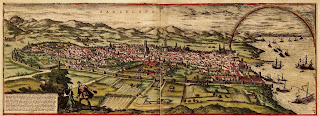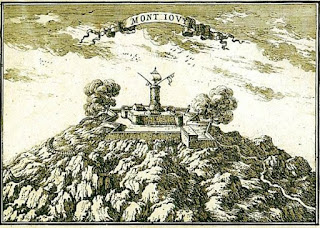 |
| The Grandma & Claire visit Montjuïc, Barcelona |
Today, the weather is good and The Grandma has decided to walk out with her closer friend Claire Fontaine. They have visited Montjuïc, the historic mountain that rises between the city of Barcelona and the Mediterranean Sea.
This mountain is a great witness of the history of the city and today, the city of Barcelona commemorates the anniversary of the Battle of Montjuïc, when in January 26, 1641, the Catalan troops defended the city from the attack of the Castilian troops during the Reapers' War.
Catalan troops won this battle and protected the city from the tyranny of the Castilian troops who killed all people -civilians and militaries- who found on their way.
This battle was an episode of the Reapers' War, a conflict that had an effect in the Treaty of the Pyrenees (1659), which ceded the County of Rosselló and the northern half of the County of Cerdanya to France, splitting these northern Catalan territories off from the Principality of Catalonia and the Crown of Aragon.
Nowadays, Catalonia is an historic nation, one of the oldest European ones, whose territories are divided in two states -French and Spanish. There are other cases like this: Basque Country (France and Spain), Alsace (France and Germany), and Britain (France and United Kingdom)...
History demonstrates that borders do not determinate a community but culture does, and one of the most significate symbols of culture is language. A spoken language determinates a community and it is a vivid element of its history, past and present.
More information: Ajuntament de Barcelona
The Battle of Montjuïc took place on 26 January 1641 during the Reapers' War. A Spanish force under Pedro Fajardo launched an attack on the Catalan army led by Francesc de Tamarit, with French cavalry support.
The Catalan rebels had taken up position on the heights of Montjuïc which dominated the city of Barcelona.
The Spanish launched several concerted attempts to capture Montjuïc Castle, but were continually repulsed. Finally a large force of Catalan rebels counter-attacked from the direction of Barcelona. Large numbers of Spanish troops were killed and the remainder had to withdraw to Tarragona along the coast. The Spanish force had recently massacred hundreds of rebels who had tried to surrender at Cambrils.
The Battle of Cambrils or the Massacre of Cambrils took place in December 1640 during the Reapers' War.
 |
| Barcelona, 17th century |
The revolt had started in May-June 1640 and as a reaction the Spanish Army had occupied Tortosa in Catalonia in September. On December 8 a large army under Pedro Fajardo de Zúñiga y Requesens headed for Barcelona, passing through Cambrils. Here, a small force of Catalan rebels attempted to ambush this much larger force, before withdrawing into the town and attempting to defend it. After several days of bombardment and heavy fighting the Spanish captured the town.
When the defenders tried to surrender, some 700 of them were massacred. The three leaders were quickly trialed and executed on the garrote. The next day, more people were hanged and the city was sacked.
The Spanish army then continued in the direction of Barcelona, taking Tarragona on December 24. Later this army was decisively defeated in the Battle of Montjuïc.
More information: Museu d'Història de Catalunya (MHCAT)
The Reapers' War, in Catalan la Guerra dels Segadors, also known as Catalan Revolt was a conflict that affected a large part of the Principality of Catalonia between the years of 1640 and 1659.
The war had its roots in the discomfort generated in Catalan society by the large presence of Castilian troops during the Franco-Spanish War between the Kingdom of France and the Monarchy of Spain as part of the Thirty Years' War.
Gaspar de Guzmán, Count-Duke of Olivares, the chief minister of Philip IV, had
been trying to distribute more evenly the huge economic and military
burden of the Spanish Empire, until then supported mainly by the Crown
of Castile. But his Union of Arms policy raised hostilities and protests
all across the states of the Monarchy of Spain.
 |
| Battle of Montjuïc, 1640 |
Resistance in Catalonia was especially strong; the Catalan Courts of 1626 and 1632 were never concluded, due to the opposition of the estates against the economical and military measures of Olivares, many of which violated the Catalan constitutions.
In 1638, the canon of La Seu d'Urgell Pau Claris, known for his opposition against non-Catalan bishops who always collaborated with the Crown, was elected by ecclesiastic estate as president of the Generalitat, while Francesc de Tamarit was elected member of the Generalitat by the military estate and Josep Miquel Quintana for the popular estate.
Around 1639, both causes approached and the identification and solidarity of the peasants took place with the attitude of political distrust of the authorities. Thus the political doctrine of the uprising and the popular ideology of the revolt were formed.
Catalan peasants, who were forced to quarter Castilian troops and reported events such as religious sacrileges, destruction of personal properties and rape of women by the soldiers, responded in a series of local rebellions against their presence.
More information: Ajuntament de Barcelona
The revolt grew, until the Corpus Christi day of May 1640 in Barcelona, with an uprising known as Bloody Corpus in Catalan Corpus de Sang, under the slogans Long live the faith of Christ!, The King our Lord has declared war on us!, Long live the land, death to bad government, Reape our chains. When the bishop of Barcelona, after blessing the furious crowd, asked them: Who is your captain? What is your flag? They raised a big Christ in the Cross Statue covered with an all black cloth and shouted Here is our captain, this is our flag!.
This Bloody Corpus which began with the death of a reaper, in Catalan segador and led to the somewhat mysterious death of The 2nd Count of Santa Coloma, the Spanish Viceroy of Catalonia, marked the beginning of the conflict.
The irregular militia involved were known as Miquelets. The situation took Olivares by surprise, with most of the Spanish army fighting on other fronts far from Catalonia. The Council of Aragon demanded more military presence in Barcelona as the only way to restore the order.
 |
| Pau Claris, MHP of the Generalitat |
Pau Claris, President of the Generalitat of Catalonia, called the politician members of the all Principality in order to form a Junta de Braços or Braços Generals (States-General), a consultive body.
The calling was a success, and the presence of royal cities and feudal villages was exceptionally large. This assembly, which worked with individual voting, began to create and apply various revolutionary measures, such as the establishment of a Council of Defense of the Principality and a special tax for the nobility (the Batalló), while the tension with the monarchy grew.
At the same time, the Generalitat maintained contacts with France, in order to establish an alliance between the Principality of Catalonia and this country. By the pact of Ceret, French promised to help the Principality. In this way, the States-General presided by Pau Claris proclaimed the Catalan Republic under the protection of the French monarchy, on January 17, 1641, which lasted a week until January 21, 1641, when they declared the French king Louis XIII Count of Barcelona as Louis I.
The threat of the French enemy establishing a powerful base south of the Pyrenees caused an immediate reaction from the Habsburg monarchy. The Habsburg government sent a large army of 26,000 men under Pedro Fajardo to crush the Catalan Revolt.
On its way to Barcelona, the Spanish army retook several cities, executing hundreds of prisoners, and a rebel army of the Catalan Republic was defeated in Martorell, near Barcelona, on January, 23.
In response the Catalans reinforced their efforts and the Franco-Catalan armies obtained an important military victory over the Spanish army in the Battle of Montjuïc (January 26, 1641).
More information: The Culture Trip
Despite this success, the peasant uprising was becoming uncontrollable in some places, progressively focusing on the Catalan nobility and Generalitat itself. In effect, the conflict was also a class war, with the peasants revolting both against the Habsburg monarchy and against their own ruling classes, which turned to France for support.
For the next decade the Catalans fought under French vassalage, taking the initiative after Montjuïc. Meanwhile, increasing French control of political and administrative affairs -maritime ports, taxes, key bureaucratic positions- and a firm military focus on the neighbouring Spanish kingdoms of Valencia and Aragon, in line with Richelieu's war against Spain, gradually undermined Catalan enthusiasm for the French.
 |
| Battle of Montjuïc, 1641 |
A Franco-Catalan army under Philippe de La Mothe-Houdancourt moved south and gained several victories against the Spanish, but the sieges of Tarragona, Lleida and Tortosa finally failed and the allies had to withdraw. In the north of Catalonia in Rosselló, they were more successful. Perpinyà was taken from the Spanish after a siege of 10 months, and the whole of Rosselló was under French control. Shortly after, Spanish relief armies were defeated at the Battle of Montmeló and Battle of Barcelona.
In 1652 a Spanish offensive captured Barcelona bringing the Catalan capital under Spanish control again. Irregular resistance continued for several years afterwards and some fighting took place north of the Pyrenees but the mountains would remain from then on the effective border between Spanish and French territories.
The war was concurrent with the Arauco War in Chile where the Spanish fought a coalition of native Mapuches. With the Arauco War being a lengthy and costly conflict the Spanish crown ordered its authorities in Chile to sign a peace agreement with the Mapuche in order to concentrate the empire's resources in fighting the Catalans. This way the Mapuche obtained a peace treaty and a recognition on behalf of the crown in a case unique for any indigenous group in the Americas.
The conflict extended beyond the Peace of Westphalia, which concluded the Thirty Years' War in 1648 but remained part of the Franco-Spanish War (1635-1659) with the confrontation between two sovereigns and two Generalitats, one based in Barcelona, under the control of Spain and the other in Perpinyà, under the occupation of France.
In 1652 the French authorities renounced Catalonia, but held control of Rosselló, thereby leading to the signing of the Treaty of the Pyrenees in 1659.
More information: The Gates Hotel Barcelona
Here is our captain, this is our flag!
Catalans, let's go to fight!
The King our Lord has declared war on us!
Catalans, let's go to fight!
The King our Lord has declared war on us!
Popular Romance
I am very impressed with your post because this post is very beneficial for me and provide a new knowledge to me.....
ReplyDeleteREAPER Crack